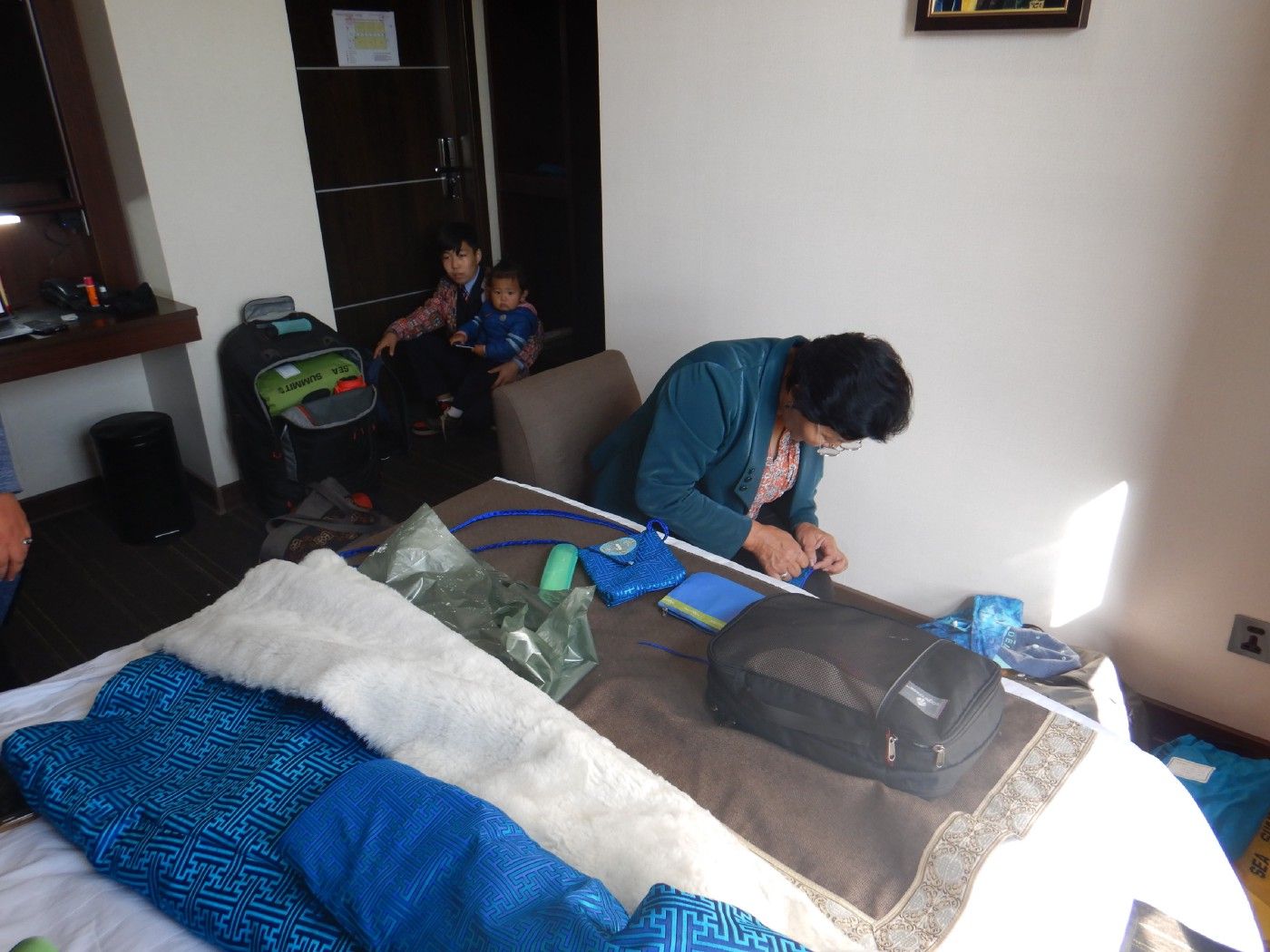Naka stood next to my bed, her hands held out as I counted out three hundred thousand Mongolian into her palm. About a hundred dollars, give or take. My prize was keeping me so warm in the small hotel room that I could barely breathe.
I could barely breathe just looking at the beauty of the damned thing.
Naka had brought the tailor (they aren’t called seamstresses over here) to my room to do a final measurement of the belt and ensure that all was perfectly fitted. About a week or so ago, Naka and a small troupe of Mongolian women had ferried me from shop to shop, buying all the parts, from the full-length sheepskin liner to the gorgeous fabrics that would make the outside my own. I handed all that over along with some key measurements at the fabric shop, and hoped.
The Mongolian deel, pronounced “del,” is the traditional garment worn by man, woman and child. There are three versions: light for summer, padded for fall, and then winter. Winter deels are characterized by either a lambskin lining (very very rare and expensive, for lambskin is only available if the lamb dies prematurely), or by processed sheepskin, which most of us are familiar with. Before I’d left on this trip, my research had unearthed a photo of a woman in a brilliant turquoise deel, and I was hooked.

My first translator, Mandy, had squired me through the stalls of the local black market where I found a pretty lightweight summer deel, but that wasn’t what I wanted. Word got around, plots were hatched, women organised and took over. As long as I had the time and the cash, anything was possible.
We spent the better part of a whole day tracking down all the parts. Naka was friends with a tailor. At this point you realize that you are handing over some $318 in good faith, and all you can hope is that the final piece was worth it.

The woman, trailing two grandkids, arrived with Naka today at about 11 am. She dragged out my brand new deel, all pure white inside, and the brilliant blue-purple geometric pattern on the outside. Naka was beside herself, showing me the incredibly fine finished seams, the handmade buttons.
This kind of fine finishing is a lost art these days in fashion. I used to be able to tell what garments were made where by how they were finished on the inside. I have never seen finer work. This kind of hand-finishing is what makes haute couture so monumentally expensive. Machines cannot do this. Only superbly trained hands can.
The tailor immediately pulled out an extra that I hadn’t expected: a tiny square purse made of the same material, lined in silk, closed with a matching button.
I did some internal calculating. Given her skill, the quality of the fabric, the body-length sheepskin, this thing should have cost me somewhere upwards of at least $2500–3000. That’s a ballpark. I’m close. Probably undervaluing it. She put in a week’s worth of work on this piece.

As soon as Naka had me in the deel, the tiny woman nabbed the belt that needed a final fitting. In seconds she had it marked. Then Naka pulled the chair out from under my butt, the woman sat down and spent the next ten minutes finalizing her work while her two grandkids watched gravely from the door.
In no time she was done and we were taking photos.
I happily fanned out the bills to pay her, and then took the time to pay her the proper compliments on her work. It really is stunning. She was determined that I would be happy (oh my god, over the moon) and deeply proud of her work.
Naka explained to me that people like her are being sidelined because of the Mongolian desire for all things Western. I see this in the huge State department store, which is identical to nearly every mall store I ever marched in my misspent youth with the exception of the groceries on the first floor. People are dumping what ties them to a pastoral past, and embracing the future.
All of it, good bad and ugly, by my measure.
This is great for Western suppliers. Not so good for Mongolian culture.
For my part, and it is only my part, a good bit of what makes the rest of the world so interesting is that they do not look, dress and eat like us. That’s the whole point.
I can’t speak for anyone else, but as someone who used to write about fashion, it is kinda fun to have something that there is no way in the world you’ll see it walking down the street towards you. Mind you, some fashion wag may come and steal designs (that’s a very popular habit of haute couture designers, just steal and raise the price three million times for the same thing). I tracked down some Hmong tribal designs on very expensive catwalk clothing after I’d bought some indigenous skirts in Vietnam. The women who hand-sewed the original didn’t get a red cent.
And yet, we are wiping this kind of talent right out. In America, we buy Navajo-themed products, but not from Navajo designers. We are quite happy to pilfer originality from those who really were the designers even as those folks quietly disappear into the side streets, behind MickyDs and KFC and urban wastelands of sameness. This 2011 article provides a little history, but let’s be clear. We steal.
Each piece like this I buy, I buy right from the original makers as best I can. That hundred dollars will go a long way. In a fair world, she’d have made the full $2500 but I wouldn’t have been able to afford it. As it is, I am asking Naka for her information so that anyone who travels here to Ulaan Bataar and wants something similar can come away with gorgeous, wearable, original art, made by someone who didn’t steal the design from someone else.
To me, that’s true fashion. Original, alive, handmade, from the hands of those who have made them from time immemorial. Walking art.

Comments powered by Talkyard.